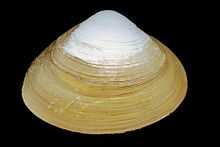Atlantic surf clam
| Atlantic surf clam | |
|---|---|
 | |
| A 15 cm adult shell of Spisula solidissima from Long Beach, Long Island, New York State. Right valve at the top, left valve at the bottom. | |
| Scientific classification | |
| Kingdom: | Animalia |
| Phylum: | Mollusca |
| Class: | Bivalvia |
| Order: | Veneroida |
| Family: | Mactridae |
| Genus: | Spisula |
| Species: | S. solidissima |
| Binomial name | |
| Spisula solidissima (Dillwyn, 1817) | |
The Atlantic surf clam, also referred to as the "bar clam," "hen clam," "skimmer," or simply as the "sea clam,"[1] is a western Atlantic surf clam, a very large (20 cm), edible, saltwater clam or marine bivalve mollusk in the family Mactridae. It is a much larger relative of the eastern Atlantic surf clam.
The shell of this species is a well-known object to beach-goers in the northeastern United States. People on the beach often pick up a large empty shell of this species, either to dig in the sand with, or take home to use as a decorative dish or ashtray.
The species is exploited commercially as a food item.

Distribution
This common species occurs off the east coast of North America from Nova Scotia to South Carolina.[2]
It has also been introduced and farmed in Hokkaidō, northern Japan.
Habitat
Atlantic surf clams lived buried in coarse or fine sand. They live offshore as well as in the low intertidal and surf zones.
Life habits
Surf clams can take as little as three months to reach maturity off the New Jersey coast, or as long as four years off Nova Scotia, and can reach an age of 31 years.[3]
These clams use their siphons to pull in and then filter fine particles of organic matter and plankton from the surrounding seawater, in other words, like almost all clams, they are filter feeders.
Human use
This species is a commercially exploited species, long prized for its sweet flavor. About two-thirds of a surf clam's shucked weight is viable for human consumption.[4] The meat of the clam is used as 'strips', chowder, and sushi.
The "tongue" or foot of the clam is commercially valuable because it is cut into long strips which are breaded and fried and served as "clam strips", first popularized by the Howard Johnson's franchise.
The meat that is left over is separated from the "belly" and is referred to as "salvage" within the clam industry. This meat includes the adductor muscles, which are the strong muscles that close the two halves of the shell and which tightly hold the clam's shell in the shut position. "Salvage" is typically ground up for use in chowders, sauces, and dips, and is commercially available either in cans or frozen. Locally it is available fresh.
As a side note, the substantial "belly" of the clam is used by knowledgeable fishermen as excellent bait for striped bass and other species.
References
- ↑ Horn, Dan. "Sea Clam". Town of Barnstable. Archived from the original on December 12, 2010. Retrieved September 15, 2009.
- ↑ Rehder, H.A. (1981). The Audubon Society Field Guide to Seashells of North America. New York: Alfred A. Knopf. ISBN 0-394-51913-2.
- ↑ Cargnelli, Luca M; Griesbach, Sara J; Packer, David B; Weissberger, Eric (1999). "Essential fish habitat source document: Atlantic surfclam, Spisula solidissima, life history and habitat characteristics" (PDF). NOAA Tech Memo (NMFS NE 142).
- ↑ "Atlantic Surf Clam". Virginia Marine Products Board. Retrieved September 15, 2009.
- The Long Island Shell Club, 1988. Seashells of Long Island, Long Island Shell Club Inc, New York State.
| |||||||||||||||||||||||||||||||||||||||||
| ||||||||||||||||||||||||||||||||||||||||||||||||||||||||||||||||||||||||||||||||||
